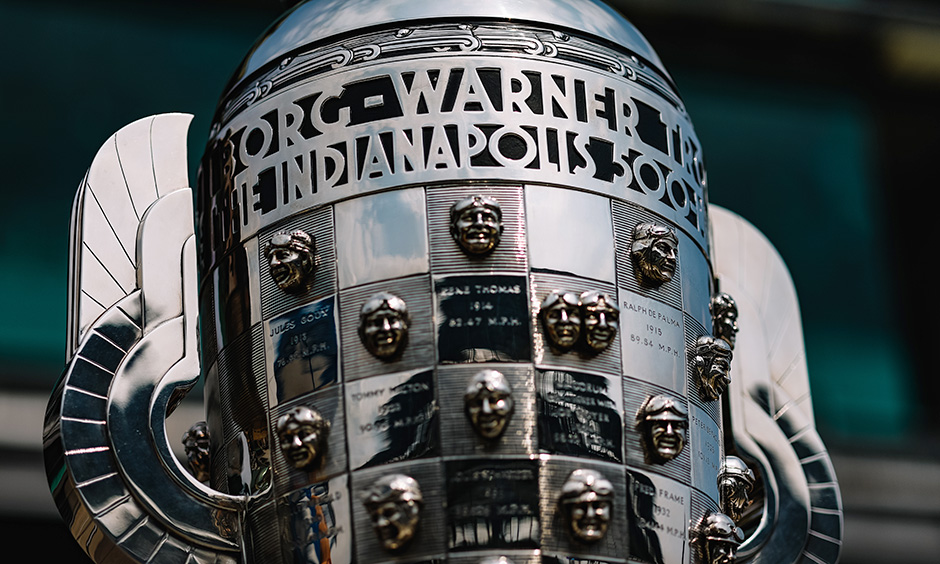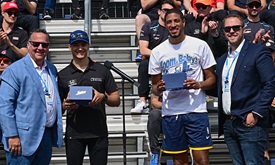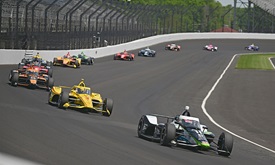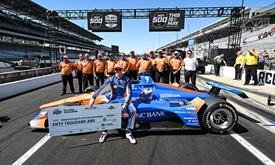500 Miles to Glory: This Year Features Fascinating Storylines
MAY 27, 2023
And now, finally, after months of anticipation, we’re on it.
Upon the gates opening at 6 a.m., the 107th Indianapolis 500 presented by Gainbridge will begin to present itself in all its glory, a crowd estimated at 325,000 filling Indianapolis Motor Speedway’s acreage, a motorsports extravaganza like no other on Memorial Day weekend.
SEE: Starting Lineup
You know the order of the pre-race tributes: an invocation, the playing of “Taps,” the singing of “God Bless America,” the national anthem and “Back Home Again in Indiana” with a spectacular flyover by four U.S. Air Force F-16 Viper jets mixed in.
Honoring America. Celebrating Indy.
And then comes the roar of the engines, with a green flag set for 12:45 p.m. ET.
A worldwide audience figures to again see a grand show. This is projected to be the event’s largest gathering since the 100th Running in 2016, and the pursuit of motorsports immortality will follow.
By Sunday sunset, a driver’s legacy will have a new dawn – unless, of course, the winner arrives in Victory Circle for a second, third or, get this, a fifth time.
There won’t be a fence tall enough if Helio Castroneves sets the record for “500” victories in a career. Takuma Sato can also reach an elite group if he wins his third such race while becoming only the third driver to win with three different teams. Seven drivers can earn their second likeness on the Borg-Warner Trophy, foremost in that group is Scott Dixon, who has been tantalizingly close several times since donning the winner’s wreath in 2008.
Tony Kanaan, the 2013 winner and the people’s choice, will send IMS into a frenzy if he turns his last ride into a winning one. He, as well as Castroneves, can become the oldest race winner in history.
The International Sweepstakes, as this event was originally called, is as global as global gets. The first six starters in this race hail from six different countries, with an all-European front row for the first time ever. The overall field breakdown is 20 international drivers and 13 others carrying the flag of America’s red, white and blue.
A Spaniard is on the pole for the first time, and an Argentine is competing for the first time since 1940. The rest of the drivers are Aussies, New Zealanders, Japanese, Brazilians, Dutch, Danes, Swiss, French, Canadians, Mexicans, English and, yes, even Hoosiers.
Ed Carpenter and Conor Daly are the local favorites, and they happen to be teammates again at Ed Carpenter Racing. Carpenter will compete for the 20th time, which means that should he win he will set the record for most starts before doing so. Given that his family owned IMS for more than 74 years, a victory also would be emotionally indescribable. Daly would stir similar emotions given that he has lived in Central Indiana for each day of his life, with his father, Derek, competing in the race six times and his stepfather, Doug Boles, serving as the track president since 2013.
Katherine Legge was already one of nine women to have taken a green flag in this race, but she is back in the field for the first time since 2013 and now stands as the fastest woman ever at IMS. Sarah Fisher is another of the women to have competed in the “500,” and she will again drive the hardtop convertible Chevrolet Corvette Z06 Pace Car in the race.
Reigning “500” champion Marcus Ericsson will try to become the first driver to win consecutive races since Castroneves in 2002. A win by Christian Lundgaard, David Malukas or rookie Sting Ray Robb will break Troy Ruttman’s youngest-winner record that has stood since 1952. The most recent of the 10 rookie winners was Alexander Rossi in 2016; there are four rookies in this field – Robb, Agustin Canapino, Benjamin Pederson and RC Enerson.
Alex Palou starts from the pole, which is enviable for many reasons but mostly because that’s where the most “500” winners have started (21). History says it’s best to start up front as nearly half of the winners (42.4 percent) began on the front row. That also bodes well for Rinus VeeKay and Felix Rosenqvist, who combined with Palou to form the fastest front row ever.
Speaking of speed, this is the third consecutive year that the field became the fastest in race history (232.184 mph), and Palou became the fastest pole winner at 234.217 mph.
History also says drivers should use numbers 1 through 7 as their car numbers as they have won 49 times. Most victorious is No. 3, which Scott McLaughlin carries. Second in “500” success is No. 2, used this year by Josef Newgarden. Both drivers are employed by Team Penske, which is seeking its record-extending 19th “500” victory.
Team owners Chip Ganassi and Michael Andretti combine to have eight cars in the field, and a win by any one of them would be historically significant. Each team has five wins, part of a three-way tie with Lou Moore for second place behind Roger Penske’s 18.
A.J. Foyt has speedsters in Santino Ferrucci, who starts a career-best fourth, and Pedersen, the highest-starting rookie in 11th. Should either win, Foyt will have his hand in a sixth “500” victory, four as a driver and two owning another driver’s car (Kenny Brack won in 1999).
This is the 30th anniversary of Bobby Rahal’s crushing 1993 setback, the only time he was bumped from the field. This year, his son, Graham, also was bumped, and he was driving a car fielded by Rahal Letterman Lanigan Racing. Graham was in the field and then pushed out by teammate Jack Harvey, but they will compete again Sunday as Graham drives in place of the injured Stefan Wilson in one of the Dreyer & Reinbold Racing entries.
History can often be a guide for the present, and this year there are striking similarities to 1993, a race won by Emerson Fittipaldi. That year, a No. 10 car of Chip Ganassi Racing was on the pole – same this year, too. There were two drivers named Scott, again a repeat. An Andretti started 24th, which is where Marco Andretti lines up Sunday. There is a one Japanese driver and one woman in the field, just as there was then, and a Brazilian trying to win his second “500” started from the ninth position. All of that bodes well for Kanaan.
The storylines are immense, and the tradition is rich. It’s called “The Greatest Spectacle in Racing” for a reason. Soon, we’ll again experience why that’s the case.



















